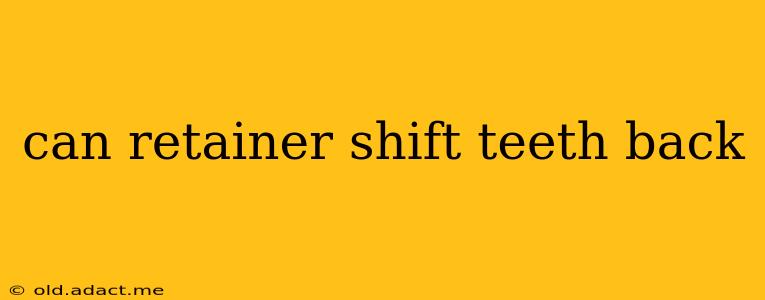Can a Retainer Shift Teeth Back? The Truth About Retainer Movement
Many people who have undergone orthodontic treatment wonder if their retainer can shift their teeth back. The short answer is: yes, a retainer can shift teeth, both forward and backward, although the extent of the movement depends on several factors. This article will explore the nuances of retainer movement and answer frequently asked questions surrounding this topic.
How Can Retainers Shift Teeth?
Retainers, particularly removable ones, apply gentle pressure to your teeth. This pressure, while subtle, can over time cause slight tooth movement. Think of it like a constant, low-level nudge. If you don't wear your retainer as directed, or if the retainer itself is ill-fitting or damaged, this pressure can lead to undesired shifts in your teeth's position. This is why consistent retainer wear is crucial for maintaining the results of your orthodontic treatment.
What Factors Determine How Much Teeth Shift?
Several factors influence how much your teeth can shift with a retainer (or lack thereof):
- Type of Retainer: Fixed retainers (bonded to the back of your teeth) offer superior stability and prevent significant shifting. Removable retainers, while convenient, are more prone to allowing tooth movement.
- Frequency of Wear: The more consistently you wear your retainer as prescribed by your orthodontist, the less likely your teeth are to shift. Missing even a few days can lead to noticeable changes.
- Age: Younger individuals generally experience more tooth movement than older adults due to the ongoing changes in their jawbone.
- Severity of Initial Misalignment: Teeth that were severely misaligned before treatment may be more prone to shifting back.
- Jawbone Density: Stronger jawbones offer more resistance to tooth movement, while weaker jawbones might be more susceptible.
- Retainer Fit: A well-fitting retainer is essential. A loose retainer will not provide sufficient pressure to maintain alignment, while a too-tight one can cause discomfort and potential damage.
Can My Retainer Shift My Teeth Back Even If I Wear It Consistently?
Even with consistent wear, minor shifting is possible, particularly with removable retainers. This is usually minimal and can often be corrected with adjustments by your orthodontist. However, diligent and proper retainer use significantly minimizes the chances of significant relapse.
What Happens if My Teeth Shift Back After Treatment?
If you notice your teeth shifting, even slightly, it’s crucial to contact your orthodontist immediately. They can assess the situation, take new impressions, and potentially make adjustments to your existing retainer or create a new one. Ignoring the issue could lead to a more significant relapse requiring further orthodontic intervention.
How Long Should I Wear My Retainer to Prevent Teeth From Shifting Back?
The recommended retainer wear time varies depending on individual circumstances and your orthodontist's recommendations. It can range from a few hours a day to wearing it full-time for several months or even years. Your orthodontist will provide a personalized plan to maintain your results.
My Retainer Feels Loose. Should I Be Concerned?
A loose retainer indicates a potential problem. A loose retainer doesn't provide adequate pressure to maintain the alignment of your teeth, increasing the risk of shifting. Contact your orthodontist immediately if your retainer feels loose. They may adjust it or provide a replacement.
Conclusion
While a retainer can shift teeth back if not worn properly or if it's ill-fitting, consistent and appropriate use is key to preventing this. Regular check-ups with your orthodontist are essential to monitor the position of your teeth and ensure your retainer is functioning correctly. Open communication with your orthodontist is critical to maintain the results of your orthodontic treatment and keep your smile looking its best.
